Page 28 of 415
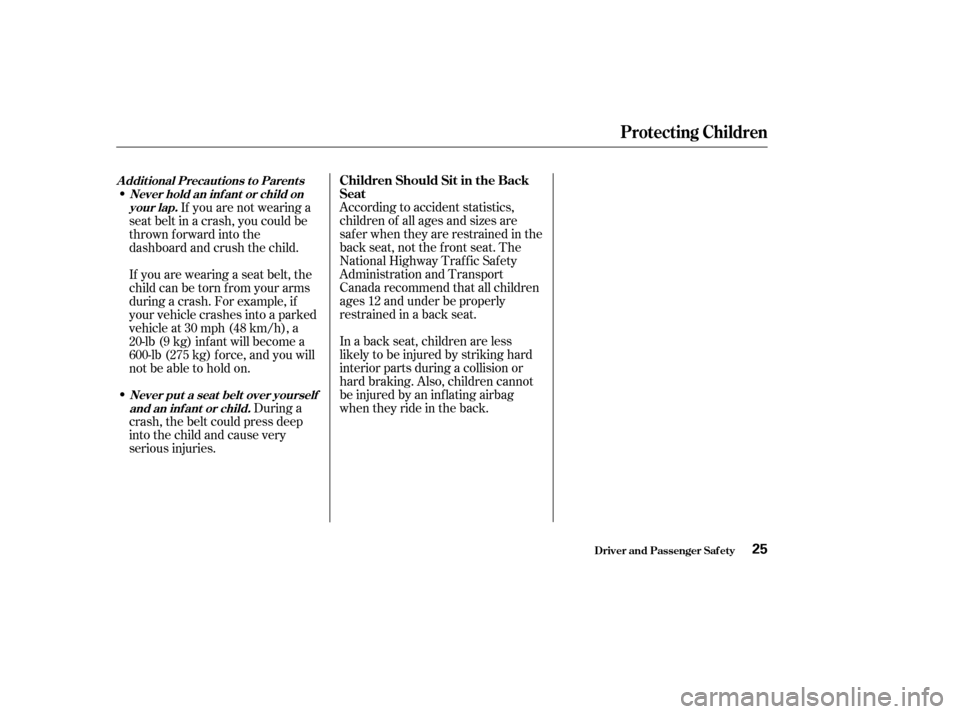
According to accident statistics,
children of all ages and sizes are
saf er when they are restrained in the
back seat, not the f ront seat. The
National Highway Traf f ic Saf ety
Administration and Transport
Canada recommend that all children
ages 12 and under be properly
restrained in a back seat.
In a back seat, children are less
likely to be injured by striking hard
interior parts during a collision or
hard braking. Also, children cannot
be injured by an inf lating airbag
when they ride in the back.
During a
crash, the belt could press deep
into the child and cause very
serious injuries. If you are not wearing a
seat belt in a crash, you could be
thrown f orward into the
dashboard and crush the child.
If youarewearingaseatbelt,the
child can be torn f rom your arms
during a crash. For example, if
your vehicle crashes into a parked
vehicleat30mph(48km/h),a
20-lb (9 kg) inf ant will become a
600-lb (275 kg) f orce, and you will
not be able to hold on.
Protecting Children
Driver and Passenger Saf ety
Children Should Sit in the Back
Seat
Never put a seat belt over yourself
and an inf ant or child.
A ddit ional Precaut ions t o Parent s
Neverholdaninfantorchildonyour lap.
25
Page 29 of 415
Front airbags have been designed to
help protect adults in a moderate to
severe f rontal collision. To do this,
the passenger’s f ront airbag is quite
large, and it can inflate with enough
f orce to cause very serious injuries.With an advanced airbag system, the
f ront passenger’s airbag is turned of f
if sensors detect a total weight of
less than about 65 lbs (30 kg) in the
seat, and the ‘‘Passenger Airbag
Cutof f ’’ indicator is turned on. (See
page f or additional inf ormation on
how the passenger’s airbag works.)
Even if the passenger’s f ront airbag
is turned of f , we strongly
recommend that inf ants, small
children, and larger children ride
properly restrained in a back seat
wheretheywillbesafer.
To help prevent airbag-caused
deaths and injuries to children, this
vehicle has an advanced airbag
system. 57
Protecting Children
Driver and Passenger Saf ety
The Passenger’s Front Airbag
Can Pose Serious Risks
26
Page 30 of 415
To remind you of the passenger’s
f ront airbag hazards, and that
children must be properly restrained
in a back seat, your vehicle has
warninglabelsonthedashboardand
on the driver’s and f ront passenger’s
visors. Please read and f ollow the
instructions on these labels.To remind you of the f ront airbag
hazards, your vehicle has warning
labels on the driver’s and f ront
passenger’s visors. Please read and
f ollow the instructions on these
labels.
U.S. Models
Canadian Models
Protecting Children
Driver and Passenger Saf ety27
Page 31 of 415
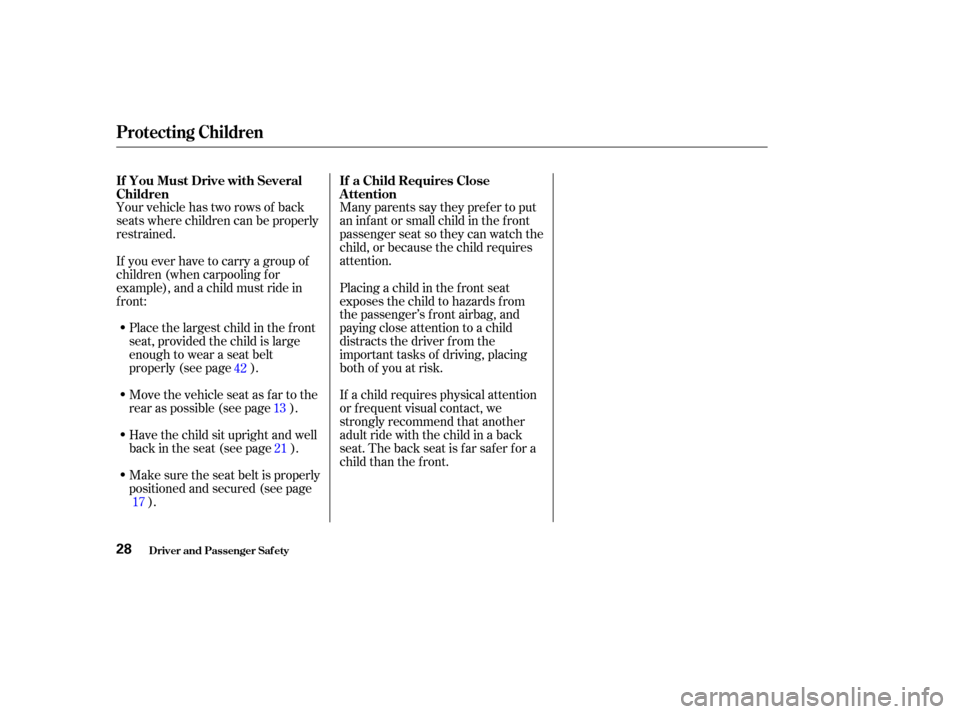
Many parents say they pref er to put
an inf ant or small child in the f ront
passenger seat so they can watch the
child, or because the child requires
attention.
Your vehicle has two rows of back
seats where children can be properly
restrained.
Place the largest child in the f ront
seat, provided the child is large
enough to wear a seat belt
properly (see page ).
Move the vehicle seat as far to the
rear as possible (see page ).
Have the child sit upright and well
backintheseat(seepage ).
Make sure the seat belt is properly
positioned and secured (see page ).
If you ever have to carry a group of
children (when carpooling f or
example), and a child must ride in
front:
Placing a child in the f ront seat
exposes the child to hazards f rom
the passenger’s f ront airbag, and
paying close attention to a child
distracts the driver f rom the
important tasks of driving, placing
both of you at risk.
If a child requires physical attention
or f requent visual contact, we
strongly recommend that another
adult ride with the child in a back
seat. The back seat is far safer for a
child than the front.
42
1321
17 If a Child Requires Close
Attention
If You Must Drive with Several
Children
Protecting Children
Driver and Passenger Saf ety28
Page 35 of 415

This page brief ly summarizes
Honda’s recommendations on where
to place rear-facing and forward-
f acing child seats in your vehicle.Recommended positions.
Properlysecurearear-facingchild
seat (see page ).
Recommended
positions. Properly secure a f ront-
f acing child seat (see page ).
To help prevent airbag-caused
deaths and injuries to children,
this vehicle has an advanced
airbag system.
With this system, the front
passenger’s airbag is turned of f
if sensors detect a total weight
of less than about 65 lbs (30 kg)
in the seat.
Even if the f ront passenger’s
airbag is turned of f , we strongly
recommend that inf ants and
small children ride properly
restrained in a back seat where
they will be saf er. Not recommended. If
a small child must ride in f ront,
move the vehicle seat to the rear-
most position and secure a f ront-
f acing child seat with the seat belt
(see page ). Never in the f ront seat, due
to the f ront airbag hazard. Not
recommended.
39
35 39
Placing a Child Seat Front Passenger’s Seat
Back Seat sInf ant s:
Small children:
Small children:
Inf ant s:
Protecting Children
Driver and Passenger Saf ety
Airbags Pose Serious
Risks to Children
32
Page 37 of 415
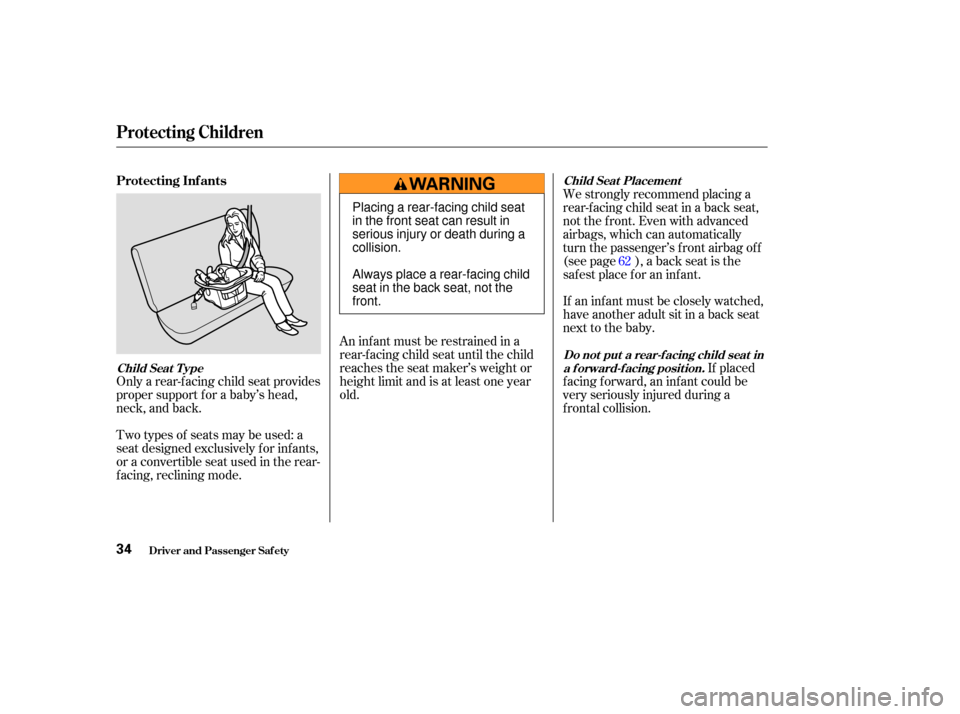
Only a rear-f acing child seat provides
proper support f or a baby’s head,
neck, and back.
Two types of seats may be used: a
seat designed exclusively f or inf ants,
or a convertible seat used in the rear-
f acing, reclining mode.An inf ant must be restrained in a
rear-f acing child seat until the child
reaches the seat maker’s weight or
height limit and is at least one year
old.We strongly recommend placing a
rear-facing child seat in a back seat,
not the front. Even with advanced
airbags, which can automatically
turn the passenger’s f ront airbag of f
(see page ), a back seat is the
saf est place f or an inf ant.
If an inf ant must be closely watched,
have another adult sit in a back seat
next to the baby.
If placed
f acing f orward, an inf ant could be
very seriously injured during a
f rontal collision. 62
Protecting Inf ants
Child Seat T ype Child Seat Placement
Do not put a rear-f acing child seat ina f orward-f acing position.
Protecting Children
Driver and Passenger Saf ety34
Placing a rear-facing child seat
in the front seat can result in
serious injury or death during a
collision.
Always place a rear-facing child
seat in the back seat, not the
front.
Page 41 of 415
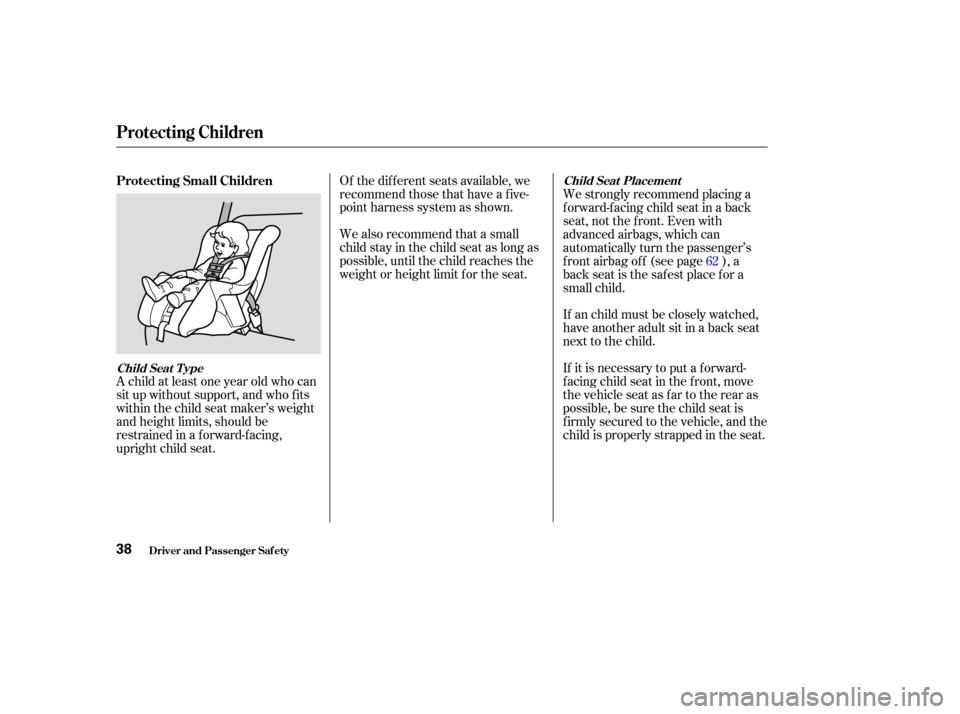
We also recommend that a small
child stay in the child seat as long as
possible, until the child reaches the
weight or height limit f or the seat. Of the different seats available, we
recommend those that have a f ive-
point harness system as shown.
A child at least one year old who can
sit up without support, and who f its
within the child seat maker’s weight
and height limits, should be
restrained in a f orward-f acing,
upright child seat. We strongly recommend placing a
forward-facing child seat in a back
seat,notthefront.Evenwith
advanced airbags, which can
automatically turn the passenger’s
front airbag off (see page ), a
back seat is the safest place for a
small child.
If an child must be closely watched,
have another adult sit in a back seat
next to the child.
If it is necessary to put a f orward-
f acing child seat in the f ront, move
the vehicle seat as far to the rear as
possible, be sure the child seat is
f irmly secured to the vehicle, and the
child is properly strapped in the seat.
62
Protecting Small Children
Child Seat T ype Child Seat Placement
Protecting Children
Driver and Passenger Saf ety38
Page 42 of 415
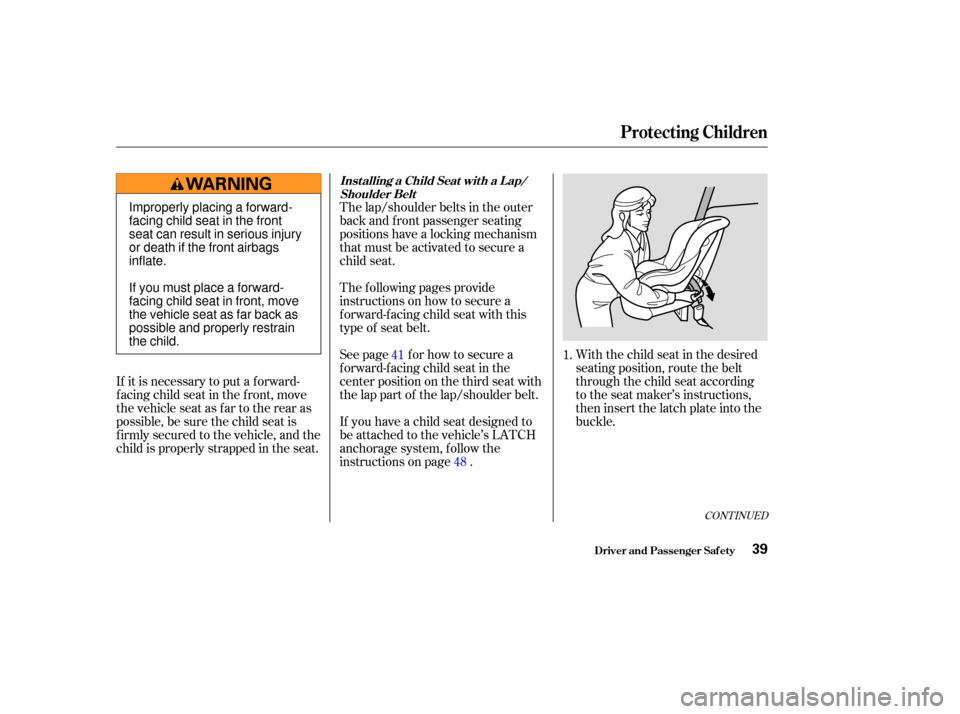
The lap/shoulder belts in the outer
back and f ront passenger seating
positions have a locking mechanism
that must be activated to secure a
child seat.
The f ollowing pages provide
instructions on how to secure a
f orward-f acing child seat with this
type of seat belt.
See page f or how to secure a
f orward-f acing child seat in the
center position on the third seat with
the lap part of the lap/shoulder belt.
If it is necessary to put a f orward-
f acing child seat in the f ront, move
the vehicle seat as far to the rear as
possible, be sure the child seat is
f irmly secured to the vehicle, and the
child is properly strapped in the seat. If you have a child seat designed to
be attached to the vehicle’s LATCH
anchorage system, follow the
instructions on page . With the child seat in the desired
seating position, route the belt
through the child seat according
to the seat maker’s instructions,
then insert the latch plate into the
buckle.
1.
41
48
CONT INUED
Inst alling a Child Seat wit h a L ap/Shoulder Belt
Protecting Children
Driver and Passenger Saf ety39
Improperly placing a forward-
facing child seat in the front
seat can result in serious injury
or death if the front airbags
inflate.
Ifyoumustplaceaforward-
facing child seat in front, move
the vehicle seat as far back as
possible and properly restrain
the child.